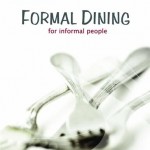Continue reading Use Your Manners at the Canada Day Barbeque
Tag Archives: dining
Napkin Etiquette By Kimberly Law AICI CIP
When setting the table, the napkin may be placed in many locations of the place setting. Often you will see the napkin in the center of the place setting or dinner plate. However it is still considered traditional to place the napkin to the left of the forks, on the bread plate, or in the glass above the main-course knife (usually the water goblet or wine glass). It should always be accessible, and never placed under the utensils. Traditionally, the napkin is never grouped the utensils on the right side of the place setting.
The purpose of the napkin is to blot your mouth and wipe your fingers… not blow your nose, or spit food into. If you need to blow your nose use a tissue discretely at the table or go to the restroom. If you put something inedible into your mouth remove it discretely and place it on the side of your plate.
No – the napkin is not a bib. Although many cultures use napkins in many different ways, in North American culture, the only time a napkin is tucked under your chin is if you have received a plastic bib to eat crab in a restaurant or are eating spaghetti and your host has lead the way. In North America and most European cultures a dinner napkin is folded in half and placed on the lap of both legs with the fold facing towards you.
After you are seated the napkin goes on your lap. In a business setting the host leads the way and the guests follow. The traditional way in a social setting would be to wait for the female host to take the lead. If you’re like me, often when I am entertaining I am in the kitchen bringing out serving dishes instead of being served by staff. If this is the case, it would be polite to lead the way by inviting the guests to start. This would be an invitation for the guests to place their napkin on their lap.
Never crumple a cloth napkin onto your plate. When finished your meal the napkin is placed on the table to the left of your place setting. This is one indication that you are finished and your dishes can be removed. If you normally eat fast, slow down and pace yourself with the host and the rest of guests. If you are a slow eater, try to speed up to keep up the pace with the diners. Wait for the host to finish before leaving your napkin on the table.
Whether dining at the dining table or the coffee table, napkin etiquette remains the same. Napkin etiquette is for holiday dining and everyday dining… enjoy!
Kimberly Law, AICI CIP
Formal Dining for Informal People
Whether we like it or not, how we handle ourselves at the dining table can impact our business and social relationships. ‘Formal Dining for Informal People’, is a great reference tool to help you appear more confident and feel more at ease when dining casually or formally. This holiday season dine with confidence!
Want to learn more about Dining Etiquette? Buy the eBook ‘Formal Dining for Informal People’ today for only $10.00
You may also be interested in:
9 Steps to Breaking Bread with Ease and Grace
If you have ever been unsure of which bread plate is yours; or whether you are supposed to butter the whole slice of bread. You are not alone. As an etiquette expert many of my clients and friends ask about the etiquette of eating bread and rolls. Here are the steps to take next time you are faced with the challenge of breaking bread.
- Your bread plate is the one to the left of your place setting.
- Don’t reach; Ask the person closest to the bread basket to pass it to you.
- Take the bread or roll and place it on your bread plate.
- Ask the person closest to the butter dish to pass it to you.
- Using the butter serving utensil (if there is one) or your butter knife (if there is no serving utensil), place some butter on your bread plate.
- Rip off a small piece of bread / roll, the appropriate size for one or two bites.
- Butter that piece of bread / roll holding it on the plate while spreading the butter.
- Eat it with your mouth closed and enjoy!
- Repeat…
Use this etiquette for Holiday Dining and Everyday Dining…Happy Holidays!
Cutlery Etiquette How to Make a Great Impression
I have travelled quite a bit over the past few years and one of the things I have noticed is that many restaurants have moved away from traditional place settings at the dining table. Although I suspect that this is part of their branding efforts to be seen as upbeat and unique, it can also be confusing and occasionally embarrassing for their patrons. This makes it more important than ever to familiarize yourself with various types of cutlery and know how to use them.
If the table is set traditionally, utensils are used starting from outside the place setting, and working in. If it isn’t use the appropriate utensil.
When holding a knife the fork is always held in the left hand. When in the left hand, the fork is held with the tines facing down. The knife is held in the right hand with the index finger on top. When eating American style after cutting the food, the knife is placed on the upper right corner of the plate and the fork is transferred to the right hand with the tines facing up for eating.
Here are a few more tips:
- Only begin eating when everyone has been served. The host picks up his or her cutlery first.
- Once a piece of cutlery is picked up, it is never put back on the table. It lies on the plate with the handle resting on the rim.
- When taking butter, use the butter knife or serving utensil to place it on your bread plate. Then use your butter knife (spreader) to butter your bread.
- Leave spoons on the service plate or saucer. An exception is made if the soup plate or soup cup has no service plate.
If you want to take a break, but don’t want your plate taken away, signal this by placing the fork and knife at right angles on the plate, tines facing down.
- When dining American Style, hands go in the lap. Wrists, arms and elbows stay off the table.
- When eating European Style, keep hands and wrists above the table at all times.
With either style the elbows stay off the table until the meal has ended.
When the meal is finished, place your fork and knife on the plate diagonally like the 10:20 clock position. The knife sits above the fork with the blade facing toward it. Napkin goes to the left of the plate… never on it. In some regions it is the custom to place the fork and knife vertically in the centre of the plate instead of the 10:20 position.





